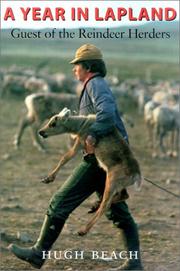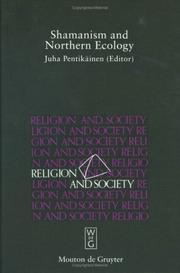| Listing 1 - 10 of 35 | << page >> |
Sort by
|
Book
Year: 2017 Publisher: London : UCL Press,
Abstract | Keywords | Export | Availability | Bookmark
 Loading...
Loading...Choose an application
- Reference Manager
- EndNote
- RefWorks (Direct export to RefWorks)
Climate change and globalisation are opening up the Arctic for exploitation by the world – or so we are told. But what about the views, interests and needs of the peoples who live in the region? This volume explores the opportunities and limitations in engaging with the Arctic under change, and the Arctic peoples experiencing the changes, socially and physically. With essays by both academics and Arctic peoples, integrating multiple perspectives and multiple disciplines, the book covers social, legal, political, geographical, scientific and creative questions related to Arcticness, to address the challenges faced by the Arctic as a region and specifically by local communities. As well as academic essays, the contributions to the book include personal reflections, a graphic essay, and poetry, to ensure wide and varied coverage of the Arctic experience – what the contributions all have in common is the fundamental human perspective. Topics covered in the essays include indigenous identity and livelihoods such as reindeer herding, and adapting to modern identities; a graphic essay on the experience of Arctic indigenous peoples in residential schools; the effects of climate change; energy in the Arctic; and extractive industries and their impacts on local communities. The book includes reflections on the future of Arcticness, engaging with communities to ensure meaningful representation and as a counterpoint to the primacy of environmental, national and global issues.
Book
Year: 2017 Publisher: London : UCL Press,
Abstract | Keywords | Export | Availability | Bookmark
 Loading...
Loading...Choose an application
- Reference Manager
- EndNote
- RefWorks (Direct export to RefWorks)
Climate change and globalisation are opening up the Arctic for exploitation by the world - or so we are told. But what about the views, interests, and needs of the peoples who live in the region? What about the myriad of other factors affecting the Arctic and its peoples? This book explores opportunities and limitations in engaging with the Arctic under change, and the Arctic peoples experiencing the change, through the lens of understanding Arcticness: what the Arctic means to Arctic peoples socially and physically. The chapters bring together a variety of disciplines, such as law, politics.
International relations. --- Civilization. --- Arctic peoples.
Book
ISBN: 0755619919 0857738445 Year: 2015 Publisher: London : I.B. Tauris,
Abstract | Keywords | Export | Availability | Bookmark
 Loading...
Loading...Choose an application
- Reference Manager
- EndNote
- RefWorks (Direct export to RefWorks)
"As climate change makes the Arctic a region of key political interest, so questions of sovereignty are once more drawing international attention. The promise of new sources of mineral wealth and energy, and of new transportation routes, has seen countries expand their sovereignty claims. Increasingly, interested parties from both within and beyond the region, including states, indigenous groups, corporate organizations, and NGOs and are pursuing their visions for the Arctic. What form of political organization should prevail? Contesting the Arctic provides a map of potential governance options for the Arctic and addresses and evaluates the ways in which Arctic stakeholders throughout the region are seeking to pursue them."--Bloomsbury Publishing.
Arctic peoples --- Law of the sea --- Political ecology --- Politics and government. --- Arctic regions
Book
ISBN: 0813163501 9780813163505 9780813153162 0813153166 0813194695 Year: 1974 Publisher: [Lexington] University Press of Kentucky
Abstract | Keywords | Export | Availability | Bookmark
 Loading...
Loading...Choose an application
- Reference Manager
- EndNote
- RefWorks (Direct export to RefWorks)
Story of an Eskimo growing up on St. Lawrence Island during 1930's and 1940's and an analysis of the major trends in socio-cultural change in a small and isolated corner of the world.
Eskimos --- Eskimauan Indians --- Esquimaux --- Arctic peoples --- Indians of North America --- Biography. --- Social life and customs. --- Kakianak, Nathan --- Childhood and youth.
Book
ISBN: 0932839568 9780932839565 9780932839558 Year: 2017 Publisher: Washington, DC
Abstract | Keywords | Export | Availability | Bookmark
 Loading...
Loading...Choose an application
- Reference Manager
- EndNote
- RefWorks (Direct export to RefWorks)
Archeologie sociale --- Fouilles (Archeologie) --- Social archaeology --- Excavations (Archaeology) --- Arctic peoples --- Prehistoric peoples --- Antiquities. --- Arctic Regions. --- Arctique --- Arctic regions --- Antiquites.
Book
ISBN: 907485138X Year: 1997 Volume: 5 Publisher: Bruxelles Bureau européen pour les langues moins répandues
Abstract | Keywords | Export | Availability | Bookmark
 Loading...
Loading...Choose an application
- Reference Manager
- EndNote
- RefWorks (Direct export to RefWorks)
Arctic peoples --- Arctische bevolking --- Arctische volkeren --- Europa --- Europe --- Laplanders --- Lapons --- Lapps --- Lapsen --- Linguistique --- Peuples arctiques --- Population arctique --- Saams --- Samis (European people) --- Taalkunde
Book
ISBN: 0801458803 9780801458804 9780801448003 080144800X 1501705660 Year: 2010 Publisher: Ithaca, NY
Abstract | Keywords | Export | Availability | Bookmark
 Loading...
Loading...Choose an application
- Reference Manager
- EndNote
- RefWorks (Direct export to RefWorks)
In Mapping the Americas, Shari M. Huhndorf tracks changing conceptions of Native culture as it increasingly transcends national boundaries and takes up vital concerns such as patriarchy, labor and environmental exploitation, the emergence of pan-Native urban communities, global imperialism, and the commodification of indigenous cultures. While nationalism remains a dominant anticolonial strategy in indigenous contexts, Huhndorf examines the ways in which transnational indigenous politics have reshaped Native culture (especially novels, films, photography, and performance) in the United States and Canada since the 1980's. Mapping the Americas thus broadens the political paradigms that have dominated recent critical work in Native studies as well as the geographies that provide its focus, particularly through its engagement with the Arctic. Among the manifestations of these new tendencies in Native culture that Huhndorf presents are Igloolik Isuma Productions, the Inuit company that has produced nearly forty films, including Atanarjuat, The Fast Runner; indigenous feminist playwrights; Leslie Marmon Silko's Almanac of the Dead; and the multimedia artist Shelley Niro. Huhndorf also addresses the neglect of Native America by champions of "postnationalist" American studies, which shifts attention away from ongoing colonial relationships between the United States and indigenous communities within its borders to U.S. imperial relations overseas. This is a dangerous oversight, Huhndorf argues, because this neglect risks repeating the disavowal of imperialism that the new American studies takes to task. Parallel transnational tendencies in American studies and Native American studies have thus worked at cross-purposes: as pan-tribal alliances draw attention to U.S. internal colonialism and its connections to global imperialism, American studies deflects attention from these ongoing processes of conquest. Mapping the Americas addresses this neglect by considering what happens to American studies when you put Native studies at the center.
Inuit --- Eskimos --- Indian arts --- Indians of North America --- Innuit --- Inupik --- Eskimauan Indians --- Esquimaux --- Arctic peoples --- Politics and government. --- Ethnic identity. --- Arts --- Tribal government --- Race identity

ISBN: 0295998628 9780295998626 0295980370 9780295980379 Year: 2001 Publisher: Seattle, WA : University of Washington Press,
Abstract | Keywords | Export | Availability | Bookmark
 Loading...
Loading...Choose an application
- Reference Manager
- EndNote
- RefWorks (Direct export to RefWorks)
Sami (European people) --- Laplanders --- Lapps --- Saam (European people) --- Saame (European people) --- Saami (European people) --- Same (European people) --- Samer (European people) --- Samit (European people) --- Arctic peoples --- Ethnology --- Finno-Ugrians

ISBN: 3110141868 3110811677 9783110811674 9783110141863 Year: 1996 Volume: 36 Publisher: Berlin New York Mouton de Gruyter
Abstract | Keywords | Export | Availability | Bookmark
 Loading...
Loading...Choose an application
- Reference Manager
- EndNote
- RefWorks (Direct export to RefWorks)
The series Religion and Society (RS) contributes to the exploration of religions as social systems - both in Western and non-Western societies; in particular, it examines religions in their differentiation from, and intersection with, other cultural systems, such as art, economy, law and politics. Due attention is given to paradigmatic case or comparative studies that exhibit a clear theoretical orientation with the empirical and historical data of religion and such aspects of religion as ritual, the religious imagination, constructions of tradition, iconography, or media. In addition, the formation of religious communities, their construction of identity, and their relation to society and the wider public are key issues of this series.
Shamanism --- Arctic peoples --- -Shamanism --- Arctic races --- Circumpolar peoples --- Hyperboreans --- -Sjamanisme. Shamanisme --- -291.612 Sjamanisme. Shamanisme --- Human ecology --- 291.612 --- 291.612 Sjamanisme. Shamanisme --- Sjamanisme. Shamanisme --- Religions --- Ecology --- Environment, Human --- Human beings --- Human environment --- Ecological engineering --- Human geography --- Nature --- Ethnology --- Religion&delete& --- Congresses --- Social aspects --- Effect of environment on --- Effect of human beings on --- Religion --- Arctic regions --- Shamanism - Congresses. --- Shamanism - Arctic regions - Congresses. --- Arctic peoples - Religion - Congresses. --- Human ecology - Arctic regions - Congresses. --- Shamanism - Arctic regions - Congresses --- Human ecology - Congresses --- Arctic peoples - Religion - Congresses --- Human ecology - Arctic regions - Congresses --- Shamanism - Congresses
Book
ISBN: 1760462632 9781760462635 1760462624 Year: 2018 Publisher: ANU Press
Abstract | Keywords | Export | Availability | Bookmark
 Loading...
Loading...Choose an application
- Reference Manager
- EndNote
- RefWorks (Direct export to RefWorks)
Indigenous efflorescence refers to the surprising economic prosperity, demographic increase and cultural renaissance currently found amongst many Indigenous communities around the world. This book moves beyond a more familiar focus on ‘revitalisation’ to situate these developments within their broader political and economic contexts. The materials in this volume also examine the everyday practices and subjectivities of Indigenous efflorescence and how these exist in tension with ongoing colonisation of Indigenous lands, and the destabilising impacts of global neoliberal capitalism. Contributions to this volume include both research articles and shorter case studies, and are drawn from amongst the Ainu and Sami (Saami/Sámi) peoples (in Ainu Mosir in northern Japan, and Sapmi in northern Europe, respectively). This volume will be of use to scholars working on contemporary Indigenous issues, as well as to Indigenous peoples engaged in linguistic and cultural revitalisation, and other aspects of Indigenous efflorescence.
Ainu --- Sami (European people) --- Social conditions. --- Laplanders --- Lapps --- Saam (European people) --- Saame (European people) --- Saami (European people) --- Same (European people) --- Samer (European people) --- Samit (European people) --- Arctic peoples --- Ethnology --- Finno-Ugrians --- Ainos --- Indigenous --- Revitalisation --- Anthropology,
| Listing 1 - 10 of 35 | << page >> |
Sort by
|

 Search
Search Feedback
Feedback About UniCat
About UniCat  Help
Help News
News